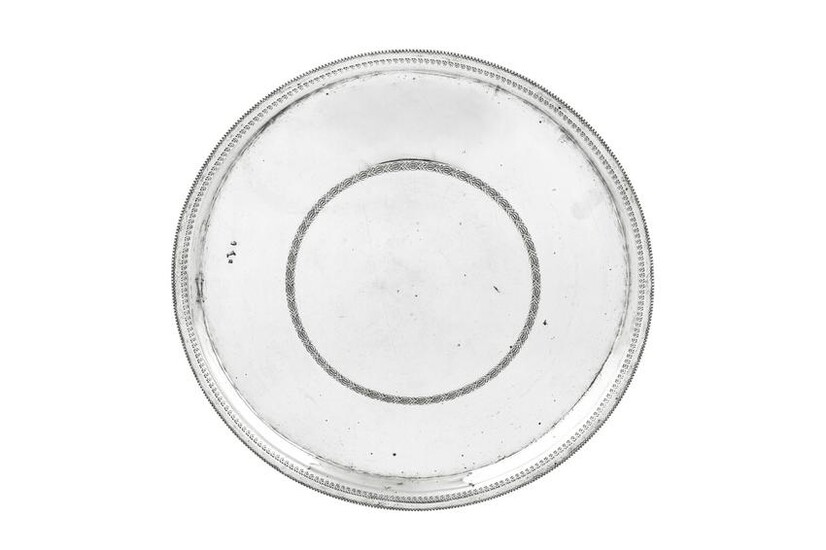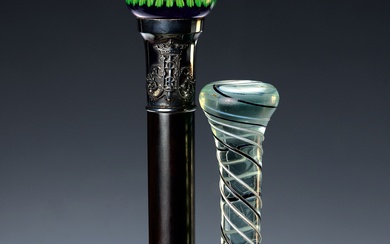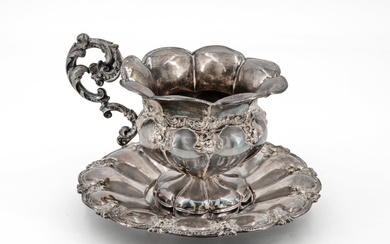A rare mid to late 19th century Egyptian 800 standard
A rare mid to late 19th century Egyptian 800 standard silver tray, Cairo circa 1870 Of circular form with an everted edge with serrated rim, the otherwise plain field with a central circular band of engine turned foliate forms, the edge with an engine turned band of rosettes. Engraved numerals to the reverse ????? (42001) to the reverse. Marked to the field with Ottoman Turkish Tughra, combined standard and town mark, and the lion passant. Diameter – 29.2 cm / 11.5 inches Weight – 639 grams / 20.54 ozt The scarcely seen lion passant mark has been discussed as being brought in during the reign of Khedive Abbas Helmy II (1892-1914) as a second precious metals law was passed in addition to the Gashanjy Law (1847) passed during the reign of Khedive Abbas I. This second law was to regulate the marking process, and stipulated standards in gold and silver, although marking was not compulsory. The silver standards were set out as minimum standards as follows; 900/800/600/450. It is not known the actual year in which the law was enacted and brought into force. However, it is disscused in Kurkman, G. (1996), Ottoman Silver Marks, Istanbul: Mathusalem, p.61 that these marks are seen during the reign of Sultan Abdulmejid I (1839-61) and Abdulaziz (1861-76) so it is more likely that the lion was mark in use from 1847. It is clear that the lion passant mark was not used after 1916, when the marking system was altered once again to become compulsory, replacing the lion with the cat for silver and the standing ibis for gold, the standards remaining the same with the abolishment of 450 standard, and the introduction of a date letter. Provenance: Victor A. Adda (Alexandria 1885-Rome 1965) who took over the family cotton trading business and formed an important collection of coins and antiquities. Thence by descent.
[ translate ]Estimate
Time, Location
Auction House
A rare mid to late 19th century Egyptian 800 standard silver tray, Cairo circa 1870 Of circular form with an everted edge with serrated rim, the otherwise plain field with a central circular band of engine turned foliate forms, the edge with an engine turned band of rosettes. Engraved numerals to the reverse ????? (42001) to the reverse. Marked to the field with Ottoman Turkish Tughra, combined standard and town mark, and the lion passant. Diameter – 29.2 cm / 11.5 inches Weight – 639 grams / 20.54 ozt The scarcely seen lion passant mark has been discussed as being brought in during the reign of Khedive Abbas Helmy II (1892-1914) as a second precious metals law was passed in addition to the Gashanjy Law (1847) passed during the reign of Khedive Abbas I. This second law was to regulate the marking process, and stipulated standards in gold and silver, although marking was not compulsory. The silver standards were set out as minimum standards as follows; 900/800/600/450. It is not known the actual year in which the law was enacted and brought into force. However, it is disscused in Kurkman, G. (1996), Ottoman Silver Marks, Istanbul: Mathusalem, p.61 that these marks are seen during the reign of Sultan Abdulmejid I (1839-61) and Abdulaziz (1861-76) so it is more likely that the lion was mark in use from 1847. It is clear that the lion passant mark was not used after 1916, when the marking system was altered once again to become compulsory, replacing the lion with the cat for silver and the standing ibis for gold, the standards remaining the same with the abolishment of 450 standard, and the introduction of a date letter. Provenance: Victor A. Adda (Alexandria 1885-Rome 1965) who took over the family cotton trading business and formed an important collection of coins and antiquities. Thence by descent.
[ translate ]






